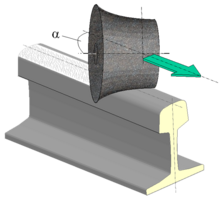High speed grinding
High-speed grinding , also English High speed grinding (HSG) is a rail machining process in which railroad tracks on the basis of the principle of Umfangschleifens be ground h with operating speeds of up to 100 km /.
origin
Since the 1990s, rail network operators have been increasingly discovering surface defects on their rails. Head checks, squats, corrugations and other so-called rolling contact fatigue damage result in a shorter rail service life, increased noise emissions and operational disruptions . The increased occurrence of errors is also accelerated by the steadily growing traffic loads. One consequence of this development is an increased need for rail maintenance.
However, the increasing need for maintenance is in contradiction to the ever smaller maintenance windows. Higher train densities reduce the periods in which rails can be machined. Conventional rail processing machines (e.g. grinding, milling or planing machines) only work at speeds of 1 to 10 km / h, which is why the tracks on which the machines work have to be closed to regular traffic. This means that you can work almost exclusively at night, since there are fewer trains and there are fewer disabilities.
These circumstances led to the development of high speed grinding. The process enables rails to be processed at speeds of up to 100 km / h and can therefore also be used when traffic is moving. As a regular train journey, the machine travels between freight and passenger trains.
principle
High Speed Grinding is based on the principle of peripheral grinding. The grinding bodies are mounted on grinding units and are drawn at a predefined angle to the rail by a carrier vehicle over the rails to be ground and rotated in the process. Pulling and turning at the same time removes material from the rail and counteracts overheating or one-sided wear of the grinding tools.
The normal working speed is 80 km / h.
implementation
In 2002, the Stahlberg Roensch company from Seevetal demonstrated the functionality and advantages of the grinding principle for rail grinding with the "HSG-Light" grinding trolley. The first HSG grinding train ("RC01") went into commercial operation five years later. RC01 works with four grinding units, each equipped with 24 grinding tools. In addition to regular deployments in Denmark and Switzerland, it is mainly used on heavily used and high-speed lines operated by DB Netz AG in Germany. Second generation grinding trains are now being built; In 2011 and 2012 a new grinding train ("HSG-2") was put into service in Germany.
application areas
- Preventive rail grinding to prevent material transformation that leads to surface defects
- (Autumn) Filming distance to traction and good electrical conductivity to ensure
- Grinding to reduce rail noise emissions
- So-called new layer grinding, d. H. Removal of the mill skin on new rails
See also
literature
- M. Hiensch, J. Smulders: Head Check Crack Progress in Rails. In: Eisenbahntechnische Rundschau. In: No. 6, 1999, pp. 378–382.
- S. Grassie: Riffles - Reasons and Countermeasures. In: Der Eisenbahningenieur .. In: No. 46, 1995, pp. 714–723.
- Lothar Marx, Dietmar Moßmann, Herrmann Kullmann: Working procedures for the maintenance of the superstructure. Eisenbahn-Fachverlag, Heidelberg / Mainz 2003.
- Allan M. Zarembski: The Art and Science of Rail Grinding. Simmons-Boardman Books, Omaha 2005.
- Bernhard Lichterberger: Track Compendium - Formation, Permanent Way, Maintenance, Economics. Eurailpress in DVV Media Group, Hamburg 2005.
- Marcel Taubert, Aiko Püschel: High Speed Grinding passes the test in Germany. In: International Railway Journal. July 2009, pp. 31-33.
- Rüdiger Block: grinding at 80 km / h . In: railway magazine . No. 3/2012 . Alba publication, March 2012, ISSN 0342-1902 , p. 30-31 .
Web links
- High speed grinding. Vossloh website
Individual evidence
- ↑ HSG-2 high-speed grinding train. October 4, 2012, accessed August 14, 2013 .

